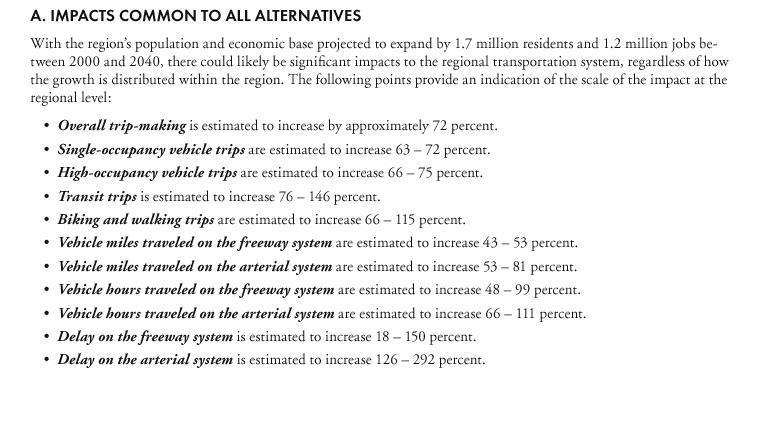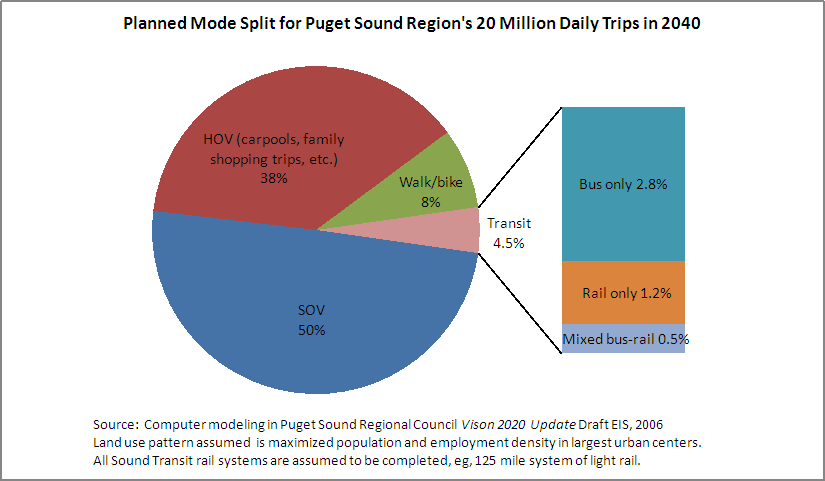![]()
![]()
The Northwest Progressive Institute posted an audio recording of an interview with Sound Transit Board Chairman John Ladenburg, that is preceded by the interviewer Andrew Villeneuve summarizing the results of a Sound Transit poll fielded in early April:
76% percent of those polled say they believe the 2007 Roads & Transit package will help fight congestion in Puget Sound, with close to half saying it would “help a great deal”. Only 18% said they did not think would not help much.
This opinion polling of what people believe about traffic congestion sharply contradicts what the official computer modeling of central Puget Sound regional traffic forecasts. This modeling comes from the Puget Sound Regional Council (PSRC), which is the regional transportation planning organization designated by both the state and federal government.
PSRC's computer modeling of the future (year 2040) performance of the full implementation of the existing Destination 2030 Metropolitan Transportation Plan shows that growing traffic congestion is the expected result. Four modeled alternatives -- each one including the full implementation of the $47 billion Roads and Transit package from Sound Transit and RTID -- range from the continuation of present trends and policies, to an alternative yielding much increased densification of housing and commercial space near future light rail and commuter rail train stations. Growing traffic congestion and falling transit market share will occur under all four land use pattern and density alternatives.
Here's the bad news in detail -- an excerpt on performance impacts extracted from the PSRC forecast of its Destination 2030 Metropolitan Transportation Plan performance:

Source document: Page 5.3.12 of the Draft EIS for the Vision 2020 Update (external pdf).
In the last two bullets, note the inability of the freeway and arterial systems, following implementation of Metropolitan Transportation Plan improvements, to handle increases in traffic volume. Delay on regional arterials is seen to be headed somewhere between doubling (100% increase) and quadrupling (300% increase).
This forecast indicates a spectacular failure of existing planning organizations and processes, since the Destination 2030 Plan includes all the projects specified in both the Sound Transit Long Range Plan for 125 miles of light rail and in the Regional Transportation Investment District (RTID) plans for highway improvements. The spending needed to implement all of Destination 2030 would be billions and billions more than the $47 billion contemplated for the combined ST2 and RTID tax measure in November 2007.
Sound Transit weakly admits in an April 5, 2007 working draft of promotional materials, "The investments planned as part of ST2 will not end congestion on the freeways. However, the will provide an alternative for drivers caught in traffic..." This alternative is represented in the Destination 2030 and ST2 plans by eventual implementation of Sound Transit's Central Link and Sounder railroad service between designated regional urban growth centers such as the downtowns of Seattle, Tacoma, Bellevue, and Everett. Link light rail and Sounder commuter rail are intended to be the important alternative to congestion. But PSRC's forecasts for 2030 and 2040 reveal that taking the train is going to be the choice of very few people. The expectations for future transit market share have actually been lowered by PSRC since issuance of the Destination 2030 Plan in 2001, as shown in the following table:
| PSRC's Transit Market Share Forecast for Full Implementation of Destination 2030 Transportation Plan | |||
| 2001 forecast for 2030 | 2006 forecast for 2040 with no policy changes | 2006 forecast for 2040 with major policy changes | |
| Work Trips | 11.8% | 11.6% | 11.7% |
| All Other Trips | 3.3% | 2.5% | 3.1% |
Source: PSRC, Destination 2030, and Vision 2020 Update DEIS
The transit market share for all types of trips combined is 4.5%. The complete modal splits for all 20 million trips per day forecast in 2040 under the current Destination 2030 Transportation Plan are shown in the following graphic:

As shown in the graphic, even with 125 miles of light rail, the official projection is that most transit rides in the region in 2040 will be aboard buses.
More details and explanation about these PSRC computer-generated forecasts are provided on this page in PITF.
PSRC's Transportation Director Charlie Howard wrote PITF that the modeling described above is not "indicative of the benefits of the ST2 and RTID packages." Mr. Howard wrote that the numbers above are "gross system-wide estimates - we all know that any improvements that are made at locations or within corridors get drowned out when 'averaged' with the facilities that are not being improved."
Editors of PITF note that most "facilities" (that is, most of the roads and bridges used by buses) cannot possibly be improved because of the billions being sucked up by the light rail construction program. Dr. Richard Harkness and others have noted that there is plenty of money for replacing Seattle's Alaskan Way Viaduct and the SR-520 Bridge if light rail were replaced with a bus transit system running on improved highways.
Washington State DOT modeling of congestion impacts of the RTID/ST2 $47 billion package has been conducted and is published by PITF. These results show a 79% reduction in traffic delay region-wide from 2006 to 2028, which is forecast to be 18% less bad than would be the case without implementation of Prop 1.
In the recorded interview mentioned at the top of this story, Sound Transit Board Chairman John Ladenburg tells us, "This is a twenty year plan to build roads and transit. So you can vote for this and look at it and say, now I know where we are going for the next 20 years in this region. And we've never known that."
We also know that John Ladenburg and Sound Transit have come up with a 20 year plan that the regional planning agency forecasts to be a failure in reducing congestion, and is furthermore a little used way of avoiding congestion, despite what polls reveal to be people's belief in early 2007 about what it does.
![]()
Return to the Public Interest Transportation Forum home page.
![]()
Last modified: February 07, 2011